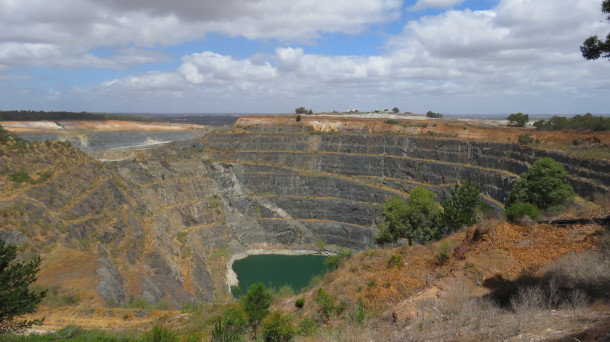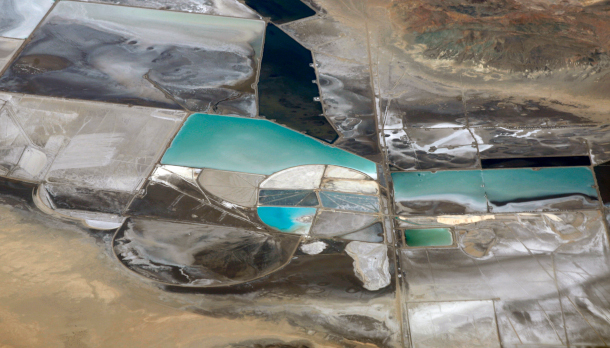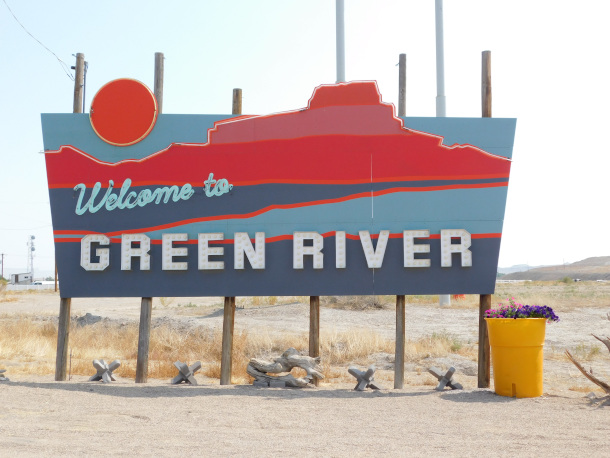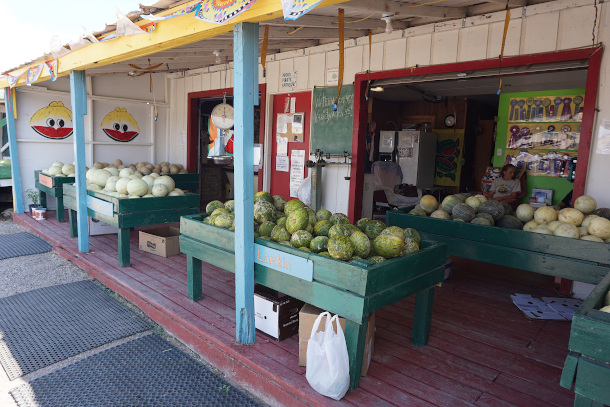Lithium from Deep Underground
Air Date: Week of April 26, 2024

The open pit of the world’s largest hard-rock lithium mine, located in Western Australia. Hard rock mines can cover many acres of land and damage local ecosystems. (Photo: Calistemon, Wikimedia Commons, CC BY-SA 4.0)
Lithium is used in electric vehicle batteries and plays a key role in the global shift towards clean transportation, but current extraction methods come with environmental costs. Some companies are exploring an alternative that taps brine water deep in the Earth. Wyatt Myskow of Inside Climate News joins Host Jenni Doering to explain how it works and what questions about its impacts remain.
Transcript
O’NEILL: It’s Living on Earth. I’m Aynsley O’Neill.
DOERING: And I’m Jenni Doering.
The lightest metal, lithium plays a key role in the global shift towards clean transportation, since it’s so useful in electric vehicle batteries. At the moment, most lithium comes from salt-flat brines and hard rock ores in Australia, Chile, and China, though the U.S. is trying to compete as well. Despite the clean energy benefits of lithium, current extraction methods come with environmental costs and health risks. Hard rock mines use heavy machinery often powered by fossil fuels and requires land to be cleared. Evaporation ponds for salt-flat brines can take up thousands of acres of land and leave behind toxic residues. One alternative that some companies are exploring is a process called direct lithium extraction, or DLE, that taps into brine water deep in the Earth. Wyatt Myskow is an investigative fellow at our media partner Inside Climate News, and he visited one proposed direct lithium extraction site in the little town of Green River, Utah.
MYSKOW: Essentially imagine like an inland sea a million years ago got trapped underground. And we don't really use it for anything. Because it's really deep in the ground, it's not safe to drink. But it can contain these trace elements of minerals like lithium. What direct lithium extraction proposes to do--and it varies from operation to operation, it's really a catch-all term—but they all involve essentially digging a well that's going to pull that water from these deep brine aquifers up to the surface, where it's going to undergo what we call an ion exchange, which is a chemical process that essentially swaps the ions of the lithium with the similarly charged ions of something not valuable to extract that lithium from the brine water. And then that brine water can be sent back into the earth. So in theory, it doesn't require as much water because the water goes back into the earth—this brine water at least. And it can require a lot less land, you don't need thousands of acres, you don't need giant holes in the ground to do this, you just need a couple of wells and a processing facility. And a really big factor that makes it an exciting option and one that might be more friendly for the environment is that it can exist with other infrastructure. So for example, at the Salton Sea in California, underneath the Salton Sea is a geothermal brine aquifer. And this water is very hot, we use it to create energy. And those facilities bring that water up to do the geothermal process. What they're proposing is, okay, we're already bringing it up, why not extract the lithium from this water, and get both the geothermal energy from it and also lithium. And a lot of these operations are not just proposing to extract lithium, but also other minerals that are found in these aquifers, to know that, hey, we're not just gonna sell lithium, we're gonna sell this as well.
DOERING: So I've also heard about these evaporation ponds that are sometimes used in lithium extraction. What are those, and how does direct lithium extraction compare?

Lithium evaporation ponds near Silver Peak, Nevada in 2010. Direct lithium extraction is an alternative method to evaporation ponds in which the brine water containing the lithium does not need to be evaporated, but can instead be returned underground after the lithium is extracted through chemical processes. (Photo: Doc Searls, Flickr, CC BY 2.0)
MYSKOW: So evaporation ponds involve also bringing that brine water up to the surface, where we put it into manmade ponds that can be pretty big. The water goes there, and the sun evaporates the water, and what's left behind is the lithium. The big difference between the two is that in an evaporation pond, that brine water is now gone, right? It's been evaporated, whereas with direct lithium extraction, that water is sent back into the ground, so it doesn't use that water.
DOERING: So some of this sounds pretty promising, potentially using less land and maybe even less water. But as I understand it, not everyone is enthusiastic about direct lithium extraction. Why is that?
MYSKOW: So even though direct lithium extraction can put the brine water back into the earth and not consume it, it can still require a lot of fresh water. Every one of these DLE operations uses a little bit different technology, a little bit different operations. And a lot of it's not really publicly available right now of how these things work. But some studies have been done that show that in some cases, they can use a lot of fresh water, more fresh water, which is the stuff we drink, then other lithium extraction methods. And so that's a big concern, especially in the Southwest, where a lot of these lithium mines are being proposed. We're in a drought down here, and there's not a ton of water, and any drop of water is going to be debated. And so environmentalists and locals in these various places like Green River, Utah, where we're seeing these operations being proposed, are concerned about how much water will be used. Another big concern is that this technology has never been used at scale in the real world. There has been lots of pilots, lots of testing for decades, but it hasn't been used the same way hard rock mining has been done. And so there's a lot of unknowns over how much impact this will really have, how much water will really be needed. And what's the impacts of removing this lithium from this water. These brine aquifers, even though they're not used for drinking water, they can be connected to aquifers that are used for human use. And that means that if you pull too much water out of one aquifer, the other one will see impacts as well. And you'll lower that water table. And that's again the concern with this direct lithium extraction operation being proposed in Green River, is that we don't know a ton about how interconnected these aquifers are. Is it connected to the Green River? It's a tributary of the Colorado, millions of people rely on the water in that river. And people really—they feel like they're being the guinea pigs for this, and they don't want to be.

The small town of Green River, Utah is the site of a proposed direct lithium extraction operation. (Photo: Jimmy Emerson, DVM, Flickr, CC BY-NC-ND 2.0)
DOERING: By the way, how much fresh water is it estimated that direct lithium extraction could require?
MYSKOW: It varies from operation to operation. The fresh water is measured in what we call acre feet, which is essentially how much water is needed to cover one acre of land under one foot of water. In Utah, that's enough water for two households for one year. So the Green River project, for example, they've acquired around 2,500 acre feet of fresh water so far to use for the process. They may use a little bit more than that. Some of the projects in the Salton Sea are more in the range of around 6,500 acre feet. Some studies have shown that maybe it might be tens of thousands of acre feet, depending how long the process is and just the technology needed. But it's certainly enough water to where a community would be concerned about the amount of water needed for this.
DOERING: Yeah. So they would be pumping this brine deep from the earth, but also potentially using water from the Green River and from other freshwater sources to be able to process the lithium out. Why might this method of using direct lithium extraction need potentially so much water?
MYSKOW: So in the Green River example, they use fresh water to essentially flush out the lithium once they've undergone the ion exchange. They use these resin beads to soak up the lithium. They need to get that lithium now out of those resin beads. And that's where the Green River water comes into play. Sometimes that fresh water is just needed for facility purposes, like keeping everything cool and at temp—there’s just a lot of different uses. It just varies from operation to operation.
DOERING: Now in the town of Green River, Utah, there are plans for a direct lithium extraction site, but the project is still in the testing stages. In your article, you talk about a well blowout that occurred there when the company began to drill. What exactly happened?

A melon stand in Green River, Utah. The town is known for its melons and has a yearly melon festival. Some residents worry that the proposed direct lithium extraction project in the town could affect freshwater supplies and impact agriculture there. (Photo: Kristina D.C. Hoeppner, Flickr, CC BY-SA 2.0)
MYSKOW: So the lithium they're targeting in this brine aquifer in Green River, Utah is about 10,000 feet underground. And right now they're undergoing, like you said, these testing operations, just trying to find out the quality of the lithium, see what's there. And they were drilling in a well, and they went around 1,500 feet, and they encountered pockets of carbon dioxide and also more water than they were expecting. And that caused the well to blow out. And that led to water of course rushing to the surface, they had to pump that water up, take it to a storage facility, divert it so it didn't go into any nearby washes or the river itself. And that caused a lot of concern from residents because, for months, they have been asking questions about what happens if a well blows out, how will this impact local water supplies, and at 1,500 feet, this water wasn't toxic, it was safe to drink. But at 10,000 feet, where you start running into even more gases, even more high pressures, where a well blowout's even more likely, you know, that water is unsafe to drink, that water has impacts if you drink it or if it touches the local farms nearby or goes into the river. And their big question is, what happens if this happens again, essentially? How are we going to stop this? How are we going to make sure it doesn't impact other uses? And so there's a lot of concern over that.
DOERING: So what kinds of economic prospects of a project like the one in Green River, Utah, are there? What's the economic situation of this, as I understand it, pretty small town, and what kind of jobs might come as a result of drilling for lithium there?

Wyatt Myskow is a reporter based in Phoenix, Arizona. He is the Roy W. Howard investigative fellow at Inside Climate News, where he covers water issues, development, public lands, wildfires and more. (Photo: Alex Gould)
MYSKOW: So Green River is a town of about 900 people. It's famous for its melon operations, they grow melons, they have a melon festival in the summer, they have signs about the melons, they have roadside attractions. So it's largely an agricultural community. And for years, there's been lots of developments being proposed in the area that residents are usually kind of skeptical of, stuff like a landfill, processing facilities, there used to be a nuclear facility in the area. There's a lot of stuff that, though it may have brought jobs, there were concerns over the impacts and how it would affect the community. This direct lithium extraction mine is no different. It's proposing around 500 construction jobs with an average salary of around $80,000 during construction, and then a permanent workforce of around 100 people with an average salary of $120,000. So that's quite a few jobs for this small community, and high paying jobs at that. And it would also raise millions in state and federal taxes. And so there's a lot of economic incentives. And for some residents, though they have this concern of, you know, what the impacts will be to the environment and how this may impact local water supplies, those high paying jobs are kind of hard to turn away. And this feels like though maybe a risky development in some ways, less risky than some of the other stuff that's been proposed in the past. But again, agriculture kind of runs this town. And as long as there's that concern over water, I think we'll see pushback from them about that.
DOERING: Wyatt Myskow is an investigative fellow at Inside Climate News. Thank you so much, Wyatt.
MYSKOW: Thanks for having me.
Links
Read Wyatt Myskow’s article about direct lithium extraction for Inside Climate News
AP News| “US Seeks New Lithium Sources as Demand for Batteries Grows”
Washington Post | “How Lithium Gets From the Earth Into Your Electric Car”
Living on Earth wants to hear from you!
Living on Earth
62 Calef Highway, Suite 212
Lee, NH 03861
Telephone: 617-287-4121
E-mail: comments@loe.org
Newsletter [Click here]
Donate to Living on Earth!
Living on Earth is an independent media program and relies entirely on contributions from listeners and institutions supporting public service. Please donate now to preserve an independent environmental voice.
NewsletterLiving on Earth offers a weekly delivery of the show's rundown to your mailbox. Sign up for our newsletter today!
 Sailors For The Sea: Be the change you want to sea.
Sailors For The Sea: Be the change you want to sea.
 The Grantham Foundation for the Protection of the Environment: Committed to protecting and improving the health of the global environment.
The Grantham Foundation for the Protection of the Environment: Committed to protecting and improving the health of the global environment.
 Contribute to Living on Earth and receive, as our gift to you, an archival print of one of Mark Seth Lender's extraordinary wildlife photographs. Follow the link to see Mark's current collection of photographs.
Contribute to Living on Earth and receive, as our gift to you, an archival print of one of Mark Seth Lender's extraordinary wildlife photographs. Follow the link to see Mark's current collection of photographs.
 Buy a signed copy of Mark Seth Lender's book Smeagull the Seagull & support Living on Earth
Buy a signed copy of Mark Seth Lender's book Smeagull the Seagull & support Living on Earth

